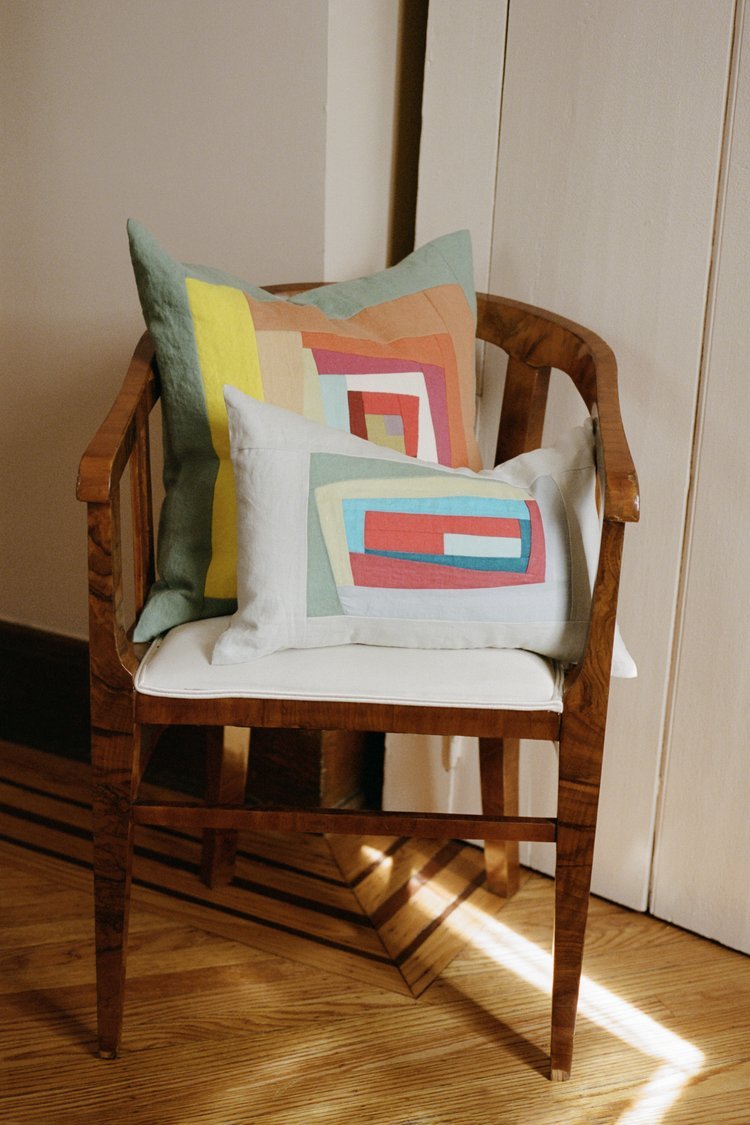Profile: In Her Own Words
Heather Greene tells Georgia Hilmer the story of ELVN, her new collection of handmade pillows
Photograph by Sean Jackson
Heather Greene is a New York-based prop stylist and set designer who has channeled many influences — her grandmother’s quilting expertise, David Hockney’s color palette, and a closet full of unusual textiles saved from set — into a new endeavor: a line of irreverent linen pillows. The collection is based on a quilt top pattern rarely deployed these days that Heather learned from her Grandma Maggie, reimagined in new materials and bold hues. The pillows embody the joy that comes from passing traditions and techniques on to future generations. The creativity and love of heritage craft sparked in Heather by her grandmother connects each pillow to the past. Yet the pillows are still distinctly modern, thanks to Heather’s use of linen (uncommon in quilting) and the fresh, energetic colors she juxtaposes. The meticulous detail with which Heather shapes each pillow — composing the color field, creating harmony from so many small scraps, stitching fickle linen — is a testament to the power and beauty of the heartfelt and handmade. Below, Heather in her own words, as told to Georgia Hilmer.
Margaret Elve Greene
The pillows started with my grandmother Margaret Elve Greene, Grandma Maggie. She was always a very, very creative person. Her mother was a milliner and she had her own interior design shop with my grandfather for many years. She knew how to do everything in a very “proper” fashion. She was an incredible seamstress and towards the end of her life really focused on quilting. She did all kinds of quilts and projects, even when getting a bit older and after my grandfather had passed while living on her own. She was feeling kind of lonely and put an ad in the paper where she was living in Florida that said, “Will teach free quilt lessons once a week.” I didn’t want to live in Florida, personally, but I was little jealous. I wanted to take those lessons, you know, but also young and not totally understanding of how amazing quilting was. I wasn't as drawn to it yet. So Grandma Maggie met with between four and six women every week and they all ended up taking classes with her for 10 or 15 years. They were her group. It's part of what kept her going. These women, they all came to her funeral, I met them. They loved her so much, and it is so moving to me, such a beautiful thing. She did projects up until she passed away, a month and a half before she would have been 95. Even when she was unable to really see my aunt would go over and make sure that needle was threaded on her sewing machine and she would just sew away while listening to books on tape.
I was forever impressed by her. I remember going to visit her, it must have been in the late 90s or early 2000s once I had already moved to New York. I was like, “I think I need a project. I don't know what to do with this energy that I have.” And she just looked at me and she's like, “I'm going to teach you how to make a pillow.” I thought, “Okay, let's do that.” We spent the whole weekend sewing that pillow, and then she taught me this quilt pattern called Lightning in the Rainforest, which I'd never heard of before. I’ve looked it up and I can't find out where it came from.
Margaret Elve Greene (at right)
I started to do a lot of research and I was really drawn to this idea of taking the Lightning in the Rainforest and honoring the initial pattern but making it a bit more contemporary. I played around with doing it in leather at one point, all kinds of things. When I was researching the pattern I happened upon the Korean sewing technique called Bojagi. I just got so excited. I'm obsessed with Bojagi now. I really started to get interested in combining these things in my mind: the patchwork of Bojagi with the Lightning in the Rainforest. I joined the Textiles Study Group of New York, and I saw that they were having a Bojagi forum in South Korea and it was one of those moments where you feel kismet, all these amazing realizations happening at once.
When everything got shut down because of Covid, with the kids and New York feeling as crazy and chaotic as it was, we realized it was better for us to get out of town for a hot minute. We rented a house in Pennsylvania and thought we were just going for two weeks but we ended up staying for almost four months. Before we left my friend Pam said, “Make sure you put your sewing machine in the car.” Thank God I did. I brought all these fabric remnants I had from different shoots and I really got to spend a lot of time trying to figure out how to do Bojagi. What's so amazing about it is it’s kind of like stained glass. You can hang a panel in the middle of a room or in a window and the light shines through. You have to make it so there's no raw edge side. I'm very drawn to it. I worked on that for a while and that kind of kept me sane.
Photograph by Georgia Hilmer for Old Stone Trade
SEVERAL MONTHS LATER I was working on a shoot, a motion shoot versus a stills shoot, in this beautiful amazing antique store. They had to record sound because there were interviews and so we'd have to sit and be really quiet for 40 minutes at a time, which I'm not used to doing on the job. I was sitting by this group of art books and I saw these colors and I was like oh my god, “What is that book?” And it was David Hockney, A Bigger Picture, and I started looking through it and his use of color to me is just absolutely extraordinary and incredibly electric and vibrant and alive. The colors he chooses to put next to each other – I'm just so impressed by it and I love it so much. I decided to treat myself to this book after the job. And that's how I made this collection of pillows: by choosing colors from my favorite paintings in the book.
Photograph by Georgia Hilmer for Old Stone Trade
I'm particularly obsessed with linen, which is not a traditional quilt fabric. There is a whole beautiful world of of history and opportunity in that material. I really like pillows, because they're so comfortable and they're comforting. Each one is custom-made because it is linen. The fabric moves and you have to pay attention to, not the grain of it but the weave of it, when you cut. So they're each hand sewn, custom made.
I think it's all very romantic. I feel really excited. It's fun to take something that someone taught me – and I'm sure somebody taught it to my grandmother – and then do a slight evolution to it that makes it feel like my own a bit as well, and then just keep going.
Photograph by Georgia Hilmer for Old Stone Trade
Photograph by Georgia Hilmer for Old Stone Trade







